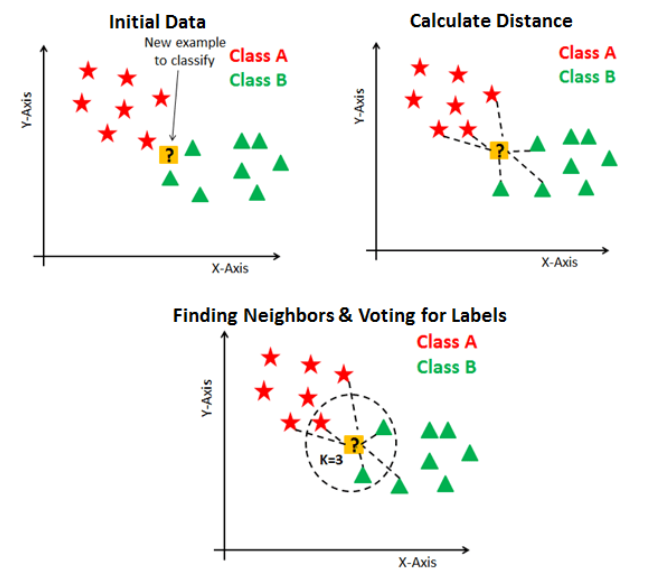

Interview Questions on KNN in Machine Learning
source link: https://www.analyticsvidhya.com/blog/2022/12/interview-questions-on-knn-in-machine-learning/
Go to the source link to view the article. You can view the picture content, updated content and better typesetting reading experience. If the link is broken, please click the button below to view the snapshot at that time.
This article was published as a part of the Data Science Blogathon.
Introduction
K nearest neighbors are one of the most popular and best-performing algorithms in supervised machine learning. Furthermore, the KNN algorithm is the most widely used algorithm among all the other algorithms developed due to its speed and accurate results. Therefore, the data science interviews might ask in-depth questions about the k nearest neighbors. In this article, we will discuss and solve advanced interview questions related to the k nearest neighbors in machine learning.

1. Why is the Time Complexity Very High For the Prediction Phase in KNN? Explain with Reasons.
In almost every machine learning algorithm, the algorithm trains first on the training data and then makes predictions based on the dataset it was prepared before. K nearest neighbor is a machine learning clustering algorithm that divides the training data into a particular number of clusters by calculating the distance of the specific points from other points. Then while predicting for careful observation, it again calculates the length of the issue and tries to settle the matter in a particular cluster to make predictions.
There are two machine learning algorithms: Lazy Learning and Eager Learning. Lazy learning is a machine learning algorithm that does not train on the training data provided. Instead, when the query is made to the algorithm to predict for it, it only trains on the training dataset. While in eager learning algorithms, the algorithm tries to teach the training data when provided. Then, when the new query is made for prediction, the algorithm predicts based on the training on the previous data. K nearest neighbor also stores the training data. Then, when there is a time for the prediction phase, this algorithm calculates the distances of the query point from other points and tries to assign the cluster to the particular topic. So it only trains on the data when a query is made to the system, which is why it is known as a lazy learning algorithm.

- As lazy learning algorithms store the data, it requires more space. That is why KNN requires more space to store.
- The reason behind the speed of the KNN is that it does not train on the training data, so training in KNN is very fast.
- As KNN trains on the training data while the prediction phase, predictions tend to be very slow in the KNN algorithm.
2. Why is KNN Algorithm Said to be More Flexible?
The K’s nearest neighbor is the non-parametric algorithm, which does not make any primary assumption while training and testing on the dataset. The parametric machine learning algorithms like linear regression, logistic regression, and naive Bayes make primary assumptions like the data should be linear or there should be no multicollinearity in the dataset. Due to this, some of the algorithms could be more flexible. If the assumptions they made are satisfied, we can only use them. For example, if the data is not linear, then linear regression cannot be applied; if the dataset has multicollinearity, then naive Bayes can not be applied.
But in the case of the KNN algorithm, as it is a non-parametric algorithm, it does not make any primary assumption on the dataset so that it can apply it to any dataset, and also it returns good results. So this is the main reason behind the flexibility of the KNN algorithm.
3. Why is KNN Algorithm Less Efficient Than Other Machine Learning Algorithms?
If you prefer flexibility, then KNN would be the best fit for the problem statement, but it also has a drawback in efficiency. Suppose one wants efficiency for the particular model. In that case, one should go for other algorithms available as KNN is not a very efficient machine learning algorithm compared to the different machine learning algorithms. As KNN is a lazy learning algorithm, it generally stores the input or the training data and does not train while the raining data is fed.
Instead, it trains when the query for prediction is made, which is the main reason behind the more time complexity in the prediction phase. While some of the eager learning algorithms, like linear regression, instantly train on the training data and predict the data very fast. So that due to this reason, KNN is said to be less efficient compared to the other machine learning algorithms.
4. Why Does KNN Performs Well on Normalized Datasets?
5. How Could the Less Value of K Lead to Overfitting in the KNN Algorithm? Explain.
Conclusion
In this article, we discussed advanced interview questions related to the k nearest neighbors and their solutions with core intuitions and logical reasons behind them. Knowledge about these concepts will help one answer these tricky and different questions efficiently.
Some Key Takeaways from this article are:
1. KNN is a lazy learning algorithm that stores the data while the training phase and does not use the stored data while the training phase. While in the predictions phase of KNN, so many calculations are involved as it is a lazy learning algorithm.
2. The time complexity for KNN in the training phase is low, and the testing phase is high, as it is a lazy learning algorithm which never does any calculations while the training phase. The space complexity also follows the same trend as time complexity in the KNN algorithm.
3. KNN is a non-parametric machine learning algorithm that provides higher flexibility and lower efficiency. As it is a non-parametric algorithm, it has no pre-assumptions like linear regression.
The media shown in this article is not owned by Analytics Vidhya and is used at the Author’s discretion.
Related
Recommend
About Joyk
Aggregate valuable and interesting links.
Joyk means Joy of geeK
